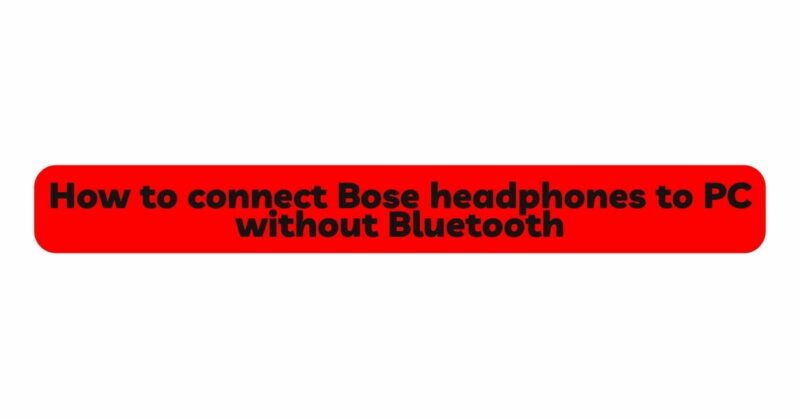Bose headphones are renowned for their superior sound quality and comfort, making them a popular choice among audio enthusiasts and casual users alike. While many Bose headphone models feature Bluetooth connectivity for seamless wireless pairing with devices, some users might prefer a wired connection for various reasons. Fortunately, connecting Bose headphones to a PC without Bluetooth is entirely possible and can offer a reliable and high-quality audio experience. In this comprehensive guide, we will explore the different methods to connect Bose headphones to a PC using wired options and delve into troubleshooting tips to ensure a smooth and enjoyable audio journey.
I. Understanding Wired Connection Options
Before we proceed, let’s familiarize ourselves with the wired connection options available for connecting Bose headphones to a PC:
- 3.5mm Audio Cable: Many Bose headphone models come with a standard 3.5mm audio cable that has a 3.5mm jack on both ends. This cable allows you to connect the headphones to the PC’s audio output (headphone jack) directly.
- USB Cable: Some Bose headphones come with a USB cable that can be connected to a USB port on your PC. This method bypasses the PC’s built-in audio system and uses the headphones’ internal DAC (Digital-to-Analog Converter) for audio processing, potentially delivering higher audio fidelity.
Now, let’s explore the step-by-step procedures for connecting Bose headphones to your PC using these wired options.
II. Connecting Bose Headphones with a 3.5mm Audio Cable
- Check Headphone Compatibility: Before proceeding, verify that your Bose headphones support a wired connection via a 3.5mm audio cable. Ensure the cable is included in the headphone package or purchase a compatible one separately.
- Identify PC Audio Output: Locate the headphone jack on your PC. It is typically labeled with a headphone icon and is color-coded green.
- Power Off Headphones: Power off your Bose headphones before making any connections.
- Connect the Cable: Insert one end of the 3.5mm audio cable into the headphone jack on your PC. The other end goes into the corresponding port on your Bose headphones.
- Adjust Headphone Settings: Once the connection is established, you may need to adjust your PC’s audio settings to ensure the sound is directed to the headphones. Go to the Sound settings in the Control Panel (Windows) or System Preferences (macOS), and set your headphones as the default audio output.
- Test the Connection: Play some audio or video on your PC to verify that the sound is coming through your Bose headphones. Adjust the volume on both the PC and headphones to a comfortable level.
III. Connecting Bose Headphones with a USB Cable
- Check Headphone Compatibility: Ensure your Bose headphones support a wired connection via USB. Verify that the necessary USB cable is included with your headphones or purchase one that is compatible with your specific model.
- Power Off Headphones: Make sure your Bose headphones are powered off before proceeding.
- Locate a USB Port: Identify an available USB port on your PC. The USB port should be able to deliver enough power to your headphones, so it’s advisable to use a USB 2.0 or 3.0 port for a stable connection.
- Connect the USB Cable: Insert one end of the USB cable into the USB port on your PC and the other end into the USB port on your Bose headphones.
- Allow Driver Installation (if required): In some cases, when you connect your Bose headphones via USB for the first time, your PC might automatically install the necessary drivers. Follow any on-screen prompts to complete the driver installation process.
- Set Headphones as Default Audio Device: Similar to the 3.5mm audio cable connection, you may need to set your Bose headphones as the default audio output in your PC’s Sound settings.
- Test the Connection: Play audio or video on your PC to ensure that the sound is routed to your Bose headphones. Adjust the volume on both the PC and headphones as needed.
IV. Troubleshooting Tips for Wired Connections
- Check Cable and Ports: If you encounter any connectivity issues, inspect the cables and ports for any visible damage. A faulty cable or port can disrupt the connection.
- Update Audio Drivers: Ensure your PC’s audio drivers are up to date. Outdated drivers can lead to compatibility issues and affect audio quality.
- Verify Headphone Settings: Confirm that your Bose headphones are set to the correct input mode (3.5mm or USB) if applicable. Refer to the headphone’s user manual for instructions.
- Test on Another PC: If possible, test your Bose headphones on another PC to determine if the issue is specific to your computer.
- Power Cycle Devices: If you encounter any glitches, power off both your PC and headphones, then power them back on to reset the connection.
- Try Different USB Ports: If you are using a USB connection, test different USB ports on your PC. Some ports may not provide enough power or have compatibility issues.
Conclusion
Connecting your Bose headphones to your PC without Bluetooth is a straightforward process that opens the door to a high-quality, wired audio experience. By using a 3.5mm audio cable or a USB cable, you can enjoy the renowned sound quality that Bose headphones offer without relying on wireless technology. Follow the step-by-step procedures provided in this guide, and if you encounter any issues, refer to the troubleshooting tips for seamless connections.
Whether you choose the traditional 3.5mm audio cable or the advanced USB connection, the joy of immersing yourself in your favorite music, movies, or games with Bose headphones remains unparalleled. Embrace the wired and wonderful world of audio, and savor every moment of your acoustic journey with Bose and your PC.


